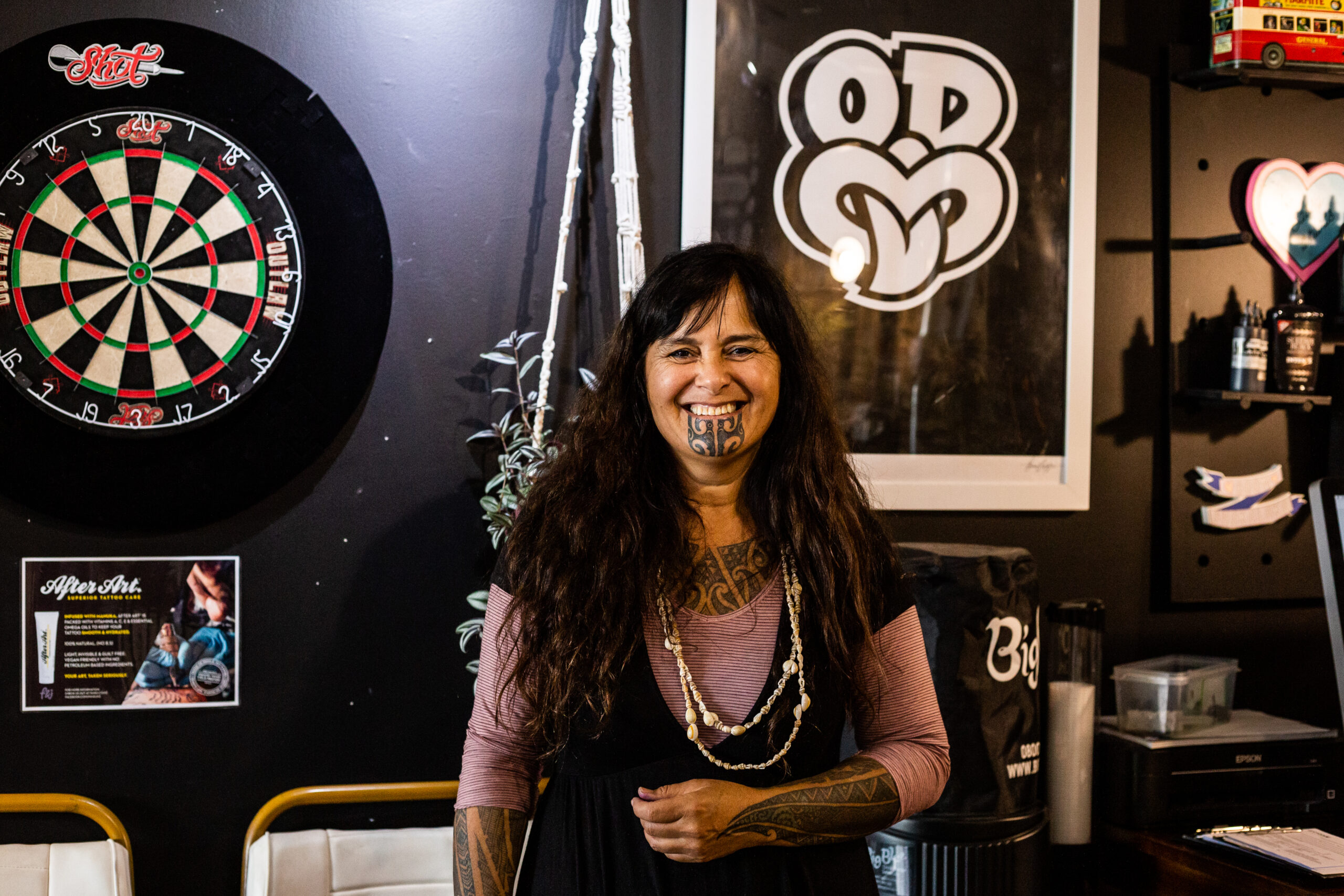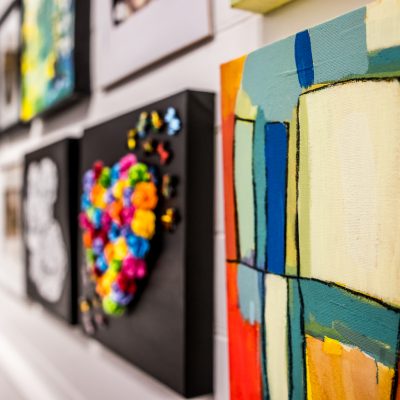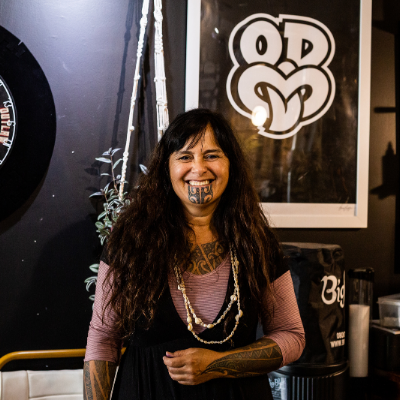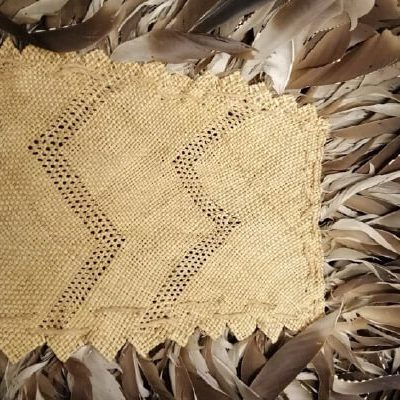Creative Patapatai
What motivates Julie Paama-Pengelly to be an artist? The prosperity and development of a healthy future for Māori people. Read on to discover Julie’s favourite place in the Bay, her most admired figures from history, and why, as a creative, you should question everything.
Your occupation, job title, artistic discipline (or very brief description of what you do)
I am a multidisciplinary artist who is committed to the premise that Māori artistic development is equated with Māori development because before written literacy, Māori arts were the primary form of communication in union with our spoken te reo. I own Art Body Creative Studio and am a Trustee for Te Tuhi Mareikura Charitable Trust, both of which I am passionate about. My practice falls within contemporary Māori art and I count my specialities as Tā moko artist, educator, consultant, writer, designer, printmaker and painter.
What cities/towns have you lived in (or spent more than a few months in) beginning with the place of your birth?
I was born in New Plymouth and after my father passed when I was 3 years old, I was raised for the majority of my life in Johnsonville, Wellington. I attended boarding school for 5 years in Masterton during this time and after I left school I went to Massey University in Palmerston North where I spent a total of nine years as a student and a teacher while I studied much of my degrees there by distance learning. I raised my children in New Plymouth for 5 years, Whakatane for 5 years and I moved back to Tauranga nine years ago to reconnect with my tribal roots of Matakana Island.
What are the earliest stories you remember hearing? The ones that told you about the world?
I listened to Sunday kid’s programmes on the radio so it was the Magic Garden, Bad Jelly the Witch and Nathaniel and the Golden Apples. I’m not sure what they taught me about the world but I think I am a believer that every wrong can be righted!

What’s your favourite Bay of Plenty landscape, park, building, location, suburb, or side street? Why?
My favourite position in Tauranga is atop Mauao, Mount Maunganui because when I stand on top and look across at Matakana Island with my back to the city, I can imagine the world of my ancestors, before progress, their life and hardships, their world. I prefer solitude up there though; that’s pretty hard to find!
What’s an average day in your life at present?
Currently I’m in Tahiti, unexpectedly. Due to Covid I’ve come to pick up my partner who, due to NZ border closures, cannot gain entry into New Zealand without me accompanying him. It’s far from an average day and mostly I am kayaking, swimming and working remotely on my computer and drawing/designing! However, recently my day has included tending to my vegetable garden first thing, walking my dog Bear on the beach, and sitting on my computer for an hour or so to correspond with my staff and tend to other business. I usually have time to catch up with my 19 year old son who is a late riser for afternoon work. If I have a tā moko booking I will head to the studio from home between 11-12 and that will be my afternoon tattooing and catching up with the studio staff and I may be spending teaching time with my apprentices as well. Otherwise in the afternoon I’ll be in my home studio working on my art, which currently is an interactive installation three-dimensional painting which I hope to exhibit in 2021. In the afternoon I enjoy catching up with my daughter (23 years) who is studying art at Toi-Ohomai and we bandy around ideas and basically solve all of the artistic problems of the world! When my partner is with me we spend more time on our creative work in my home studio.
What music was present and still memorable from your youth/adolescence?
So much music I remember vividly as I was surrounded my musical influences however, what engages my memory strongly after all these years is doing tī rakau at primary school – the māori stick song – this was back in the late 60’s to the song “E pāpā waiari’ which then endured as one of my favourite songs performed by the band Herbs. The other was Whitney Houston and the Power of Love and I have followed incredibly talented women singers ever since.
For you as a creative person, who are three influential artists or thinkers?
Robert Jahnke a visionary, incredible artist and thinker and my teacher/mentor at Art School. Ralph Hotere as an artist practitioner has always been highly influential on my practice, I believe he was a visionary as a contemporary Māori art practitioner. Ching Tutua – kaumatua and carver who supported women re-establishing their practice in Māori carving.
If you went away from the Bay of Plenty for a long time and then came back, what are the first three things you would do or visit?
Mauao both around and up, my studio because I miss everyone there and Huckleberry because I love our fresh organic produce.

Looking back at your childhood self: what one sentence describes that person?
Insular, shy and overthinker with super observational creative powers because I was an only child in my own world; left to my colouring books, reading and own devices a lot.
If you had to eat the same meal every day, what would it be?
Sounds terrible but I’m a big vegetable fan—and I consume vegetable juice every day. I don’t think I could survive on this alone, so I would have to say fresh fish and mangoes which currently I consume in abundance in Tahiti
What are you planning for 2021 that nobody knows about yet?
Radical change… but I’m not sure what that looks like…
Who are your favourite or most admired figures from history?
Rua Kenana, the Māori prophet. Te Kooti, prophet and leader who changed the nature of Māori art. Nelson Mandala and Te Hikapuhi of Ngati Pikiao (who was a proud woman tohunga healer and tā moko, and refused to stop practicing even when laws were passed to outlaw Māori practices).
If the Prime Minister asked you to make up a new policy or law for New Zealand, what would it be?
That the state would ensure the care of the wellbeing of its citizens and the interests of tangata whenua foremost in all of its policy undertakings.
In one sentence, can you define art?
An encoded visual language and repertoire of a cultural person used to challenge and express their beliefs and sense of belonging.
What is missing or lacking from your Bay of Plenty community or environment?
A compelling and extensive representation of Māori artistic history on the visual landscape. Our environment says a great deal about what we care about and to not bring the continuous stories of Maori to prevalence in our landscape excludes Maori from having a living, breathing relevance as the founding people or tangata whenua of this country. Most people would be oblivious to the monocultural nature of the artistic, architectural and contextual landscape around us but for Maori, with nature as their canvas, they no longer have the authority to vitalise their visual stories as geographical reality and essential being.
Name a few films that you consider profound, moving or extraordinary?
Rabbit Proof Fence, Malcolm X, Cry Freedom and Avatar (obviously for very different reasons).

What was your first real job, second, third?
Visual Merchandiser (flash world for window dresser) at D.I.C. Palmerston North, Fashion Designer for Brats Fashion in Palmerston North, Physical Education relief teacher at Stratford High School.
Where would you like to live, but have yet to?
Tahiti.
What word of advice would you offer an aspiring creative person?
Finding a reputable course or teacher/mentor is a must, and think ‘creatively’ as this is a state of mind that is eroded constantly by the ways of being within normal everyday society. Question everything because creative thinkers model better ways and better futures.
What’s the biggest problem about life in New Zealand? How you would solve it?
Our society based on the world economic ideology and monetary economy where members of our nation are considered hostile to the state. This breeds mistrust and divisiveness, and creativity is thereby relegated to contra-state behaviour. We should take the lessons of Covid as an opportunity to align more with the philosophies of Finland where the state represents the well-being of its citizens with a social security system to match—to intervene on behalf of the people so friction and inequalities are broken down and creativity, self-sufficiency and respect for the earth underpins our being…
What is your dream of happiness?
Painting and swimming in warmth every day
What one question would you add to this Interview?
What motivates you to be an artist? My answer: the prosperity and development of a healthy future for Māori people.

Creative Directory
Explore and connect with creative people, groups & spaces in Tauranga and Western BOP


